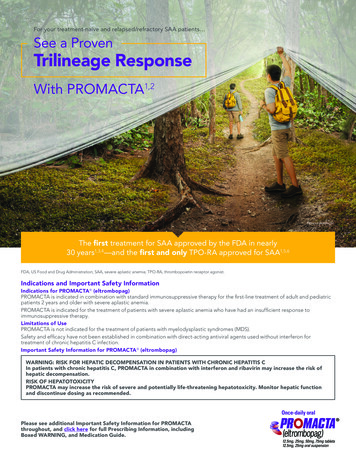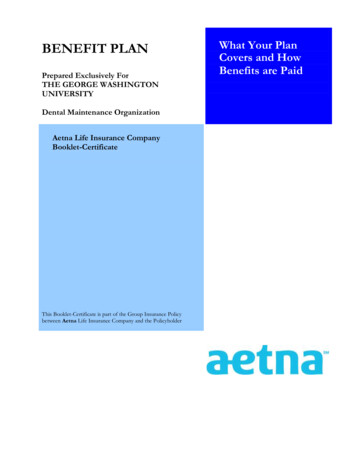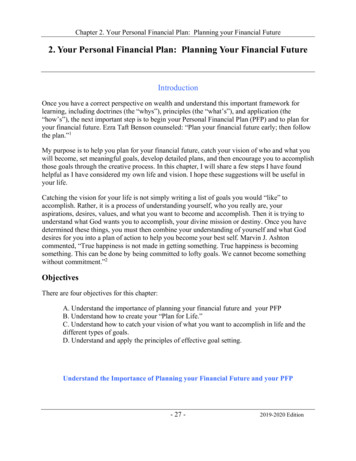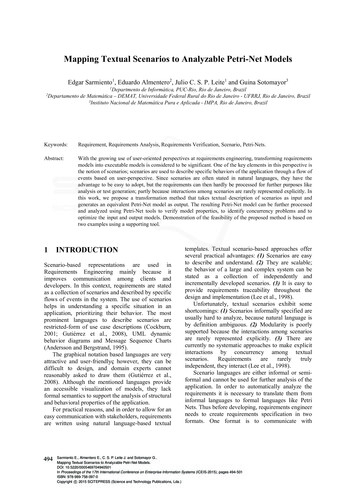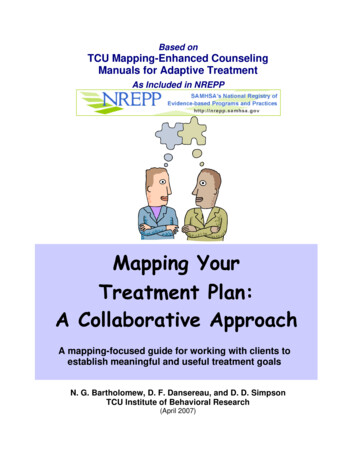
Transcription
Based onTCU Mapping-Enhanced CounselingManuals for Adaptive TreatmentAs Included in NREPPMapping YourTreatment Plan:A Collaborative ApproachA mapping-focused guide for working with clients toestablish meaningful and useful treatment goalsN. G. Bartholomew, D. F. Dansereau, and D. D. SimpsonTCU Institute of Behavioral Research(April 2007)
TCU Mapping-Enhanced Counseling manuals provide evidence-basedguides for adaptive treatment services (included in National Registry ofEvidence-based Programs and Practices, NREPP, 2008). They are derivedfrom cognitive-behavioral models designed particularly for counselors andgroup facilitators working in substance abuse treatment programs.Although best suited for group work, the concepts and exercises can bedirectly adapted to individual settings.When accompanied by user-friendly information about client assessmentsthat measure risks, needs, and progress over time, TCU MappingEnhanced Counseling manuals represent focused, time-limited strategiesfor engaging clients in discussions and activities on important recoverytopics. These materials and related scientific reports are available asAdobe PDF files for free download at http://www.ibr.tcu.edu. Copyright 2007 Texas Institute of Behavioral Research at TCU, Fort Worth,Texas 76129. All rights reserved. Permission is hereby granted to reproduceand distribute copies of this manual (except reprinted passages fromcopyrighted sources) for nonprofit educational and nonprofit library purposes,provided that copies are distributed at or below costs and that credit forauthors, source, and copyright are included on each copy. No material may becopied, downloaded, stored in a retrieval system, or redistributed for anycommercial purpose without the expressed written permission of TexasChristian University.Texas Institute of Behavioral ResearchiiTCU ( 2007)
TCU MAPPING-ENHANCED COUNSELING MANUALSFOR ADAPTIVE TREATMENTMapping Your Treatment Plan:A Collaborative ApproachTable of ContentsIntroduction: Mapping, Collaboration, and Thoughtful Plans . 1Description: Background and rationale for using node-link mapping forengaging clients in setting goals for treatment and recoverySession 1: Getting Started: First Maps . 10Description: Leader guide for using maps to explore client’s history andcurrent concerns as a foundation for setting treatment goalsSession 2: Mapping Goals and Strategies . 24Description: Leader guide for using maps to engage clients in establishinguseful and workable goals for early recoverySession 3: Mapping Progress and Future Plans . 35Description: Leader guide for using maps to help client chart successes andaddress ancillary treatment issuesAppendix: Mapping Bibliography . 50Description: Bibliography and brief abstracts of mapping research studies Copyright 2007 TCU Institute of Behavioral Research, Fort Worth, Texas. All rights reserved.Texas Institute of Behavioral ResearchiiiTCU ( 2007)
Introduction:Mapping,Collaboration, andThoughtful PlansMapping, Collaboration, and Thoughtful Plans introduces thebasics of node-link mapping, the use of structured maps fortreatment planning, and the importance of developing the counselorclient relationship through collaboration. A thoughtful treatmentplan with realistic and measurable goals helps focus the therapeuticrelationship on a more hopeful tomorrow. This chapter is designedas a primer for treatment staff interested in simple, yet effectivestrategies to strengthen motivation and engagement in treatmentthrough more effective treatment planning.Texas Institute of Behavioral Research1TCU ( 2007)
Mapping, Collaboration, and Thoughtful PlansIntroductionTreatment PlanningThe term “treatment plan” is part of clinical vocabulary from the moment a cliententers a substance abuse treatment program until (hopefully) that client issuccessfully discharged. But not all treatment plans are the same. In many cases,having a formal treatment plan for each new client is a requirement of state licensersor funding providers. In some cases, treatment plans are generated, pretty muchcookie-cutter style, then filed away, primarily so that future auditors can noteprogram compliance. Counselors working with clients seldom refer to these plans orrefer to them only in generalities (i.e., “Mary needs to be working on her selfesteem”). In other instances, pro-forma treatment plans are generated based onobserved needs or problems identified through assessments and testing, with littleclient input. As these problem areas are addressed in individual or group counselingthey are checked off the treatment plan. Once clients receive all their checks (andhave done well with their sobriety) they are considered to have completed treatment.Perhaps one of the biggest “disconnects” between substance abuse treatmentproviders and their clients centers on treatment planning. Clients often have lowexpectations of being asked to be involved in the planning process. Providers oftenbelieve clients are not capable or motivated enough to put effort into treatmentplanning. The purpose of this manual is to introduce a new strategy to help bridgethis gap. We present an offering of ideas and worksheets for clinicians to use toinvite clients into conversations about their goals and hopes for the future.We believe that these thoughtful conversations, aided by mapping-enhancedworksheets, hold the best promise for eliciting from clients the changes they want tosee in their lives, their ideas about the best way to make those changes, and theirconsiderations about how to measure progress. This type of collaborative, futurefocused treatment plan has the best chance for success because, with the help ofmapping strategies, clients are assisted in articulating and claiming ownership oftheir treatment journey.Texas Institute of Behavioral Research2TCU ( 2007)
Mapping, Collaboration, and Thoughtful PlansWhat do you mean by “mapping”?Mapping is a cognitive tool that helps organize information and ideas spatially.Most counselors have been exposed to the helpfulness of graphically displayingideas and connections. For example, Genograms use boxes and lines to help clientsbetter understand their family history over several generations.The type of mapping we use in this manual is more commonly known as “node-linkmapping.” (See Appendix for the node-link mapping bibliography.) It was firststudied as a handy tool for helping students take better notes during lengthy collegelectures. In these studies, some students were taught to take notes by placing keyideas in boxes called “nodes” that were connected to other nodes with lines (“links”)representing different types of relationships. The final product often resembled amap or flow chart of the lecture. Other students took notes as they would usuallytake them. The results showed that students who used this “node-link mapping”system did better on tests and felt more confident about understanding the lecturethan did students who took traditional notes (see Figure 1.). There seems to besomething about graphically displaying information that helps us better understandthings and recall key ideas (hopefully when we need them).Figure 1. Simple map of early mapping researchLong-winded lectureStudents wholearned to mapStudents whotook regularnotesBetter scoresLower scoresMore confidentabout understandingTexas Institute of Behavioral Research3Less confident aboutunderstandingTCU ( 2007)
Mapping, Collaboration, and Thoughtful PlansMapping as a Counseling ToolMapping has evolved as a counseling tool over the course of more than 15 years ofapplication and research. A key element – that mapping appears to help fosterunderstanding and support better recall – was seen as potentially beneficial to thecounseling relationship both for individual and group applications.Mapping serves two major functions in the counseling process. First, it provides acommunication tool for clarifying information and sharing meaning betweencounselor and client. It can be used effectively with whatever therapeutic orientationor style a counselor follows. Second, regular use of mapping-based strategies helpswith the continuity of care. Mapping worksheets or notes can be placed in theclient’s file, so that discussions of treatment issues (around goals, for example) canbe picked up where they were left off at the end of the previous session. Clients alsomay be offered copies of maps they have worked on in session to help with focusand task completion between visits.Using mapping as a clinical tool assists the counselor in structuring sessions to betteraddress key issues that are important to the client. Of course, from the client’sperspective, it is the conversation itself that is most important. Mapping can helpmake treatment conversations more memorable, help clients focus, and give clientsconfidence in their ability to think through problems and develop solutions.Another benefit of creating maps with clients is having those maps available forclinical supervision meetings. When mapping is part of the counseling process withclients, this material can be discussed jointly in supervision. Maps placed in theclient’s file document and efficiently outline the work being done in session. Thisprovides a foundation and focus for supervisors to offer specific feedback andclinical guidance.Texas Institute of Behavioral Research4TCU ( 2007)
Mapping, Collaboration, and Thoughtful PlansMapping and CollaborationCollaborative counseling approaches are emerging as effective strategies forimproving motivation and goal-setting, and for helping clients feel that they wereheard and respected during sessions. These are seen as building blocks for a strongtherapeutic alliance and for instilling hopefulness and determination as clients begintheir treatment journey. A central skill in collaborative approaches is the elicitingand highlighting of the client’s perspective. This includes encouraging clients todiscuss, with enriched detail, what needs to change in their lives, how they view thechange process, and what steps make sense for what they want to accomplish.When a counselor uses mapping to engage the client, this type of collaboration isnaturally facilitated. Maps are co-created, and the content of a map – the thoughts,ideas, and issues – are those raised and identified by the client. The map provides afocal point for this work as the counselor skillfully elicits from the client whatshould be written down, what should be noted in passing, and what should beaddressed next.As part of a collaborative model of treatment planning, counselors help clientsdevelop a clear picture of what they want to be different or improved as a result ofparticipating in treatment. This logically involves a discussion of goals and thepositive consequences of those goals. It also involves assisting the client inidentifying his or her available resources for tackling those goals. Resources areidentified broadly to include a client’s strengths, relationships, attitudes, thoughts,skills, behaviors, and perceptions.Within this framework, the counselor accepts that a client’s goals may change duringthe process of treatment and that the client is the determiner of when enoughprogress has been made toward a particular goal and when goals should be amended.Likewise, the counselor accepts that a client’s most salient and meaningful goals willoften not reference alcohol or drug use, per se. For example, saving a marriage orrelationship, getting and keeping a job, regaining a driver’s license, or committing toan educational pursuit are more commonly identified goals. Ending or controllingsubstance use becomes one of the factors or ways to achieve these major goals.Texas Institute of Behavioral Research5TCU ( 2007)
Mapping, Collaboration, and Thoughtful PlansTypes of MapsMapping CategoriesAs we have discussed, node-link maps are tools that can visually portray ideas, feelings,facts, and experiences. There are three broad categories of these maps: Free or process mapsInformation mapsGuide mapsAlthough Mapping Your Treatment Plan: A Collaborative Approach, uses the categoryof maps called “guide maps,” it is helpful for the potential user of mapping approaches tohave a broad overview of all the ways mapping can be used successfully.Free or process maps: Using an erasable board, flip chart, or paper andpencil, client(s) and counselor can work together to create a map of the problem orissue under discussion. The counselor should take the lead in briefly explainingmapping to the client(s) and providing a starting point for creating the map.However, when at all possible, both counselor and client(s) should have pencils ormarkers so that co-creation of the map is facilitated. Here is an example of a freemap or process map created during a group session on “relapse.” In this case, thecounselor created the map on an eraser board with group members’ input and led aprocess discussion on the issues raised:Free MappingPThings Learned fromRelapseP“Finally acceptedthat I need help”Hit rockbottomPPIt had been6 month sinceI usedDenialLOverConfidenceTexas Institute of Behavioral ResearchI can regain controlRealizing it“sneaks” upEx6PIDesire toquit forgoodLegendP PartL Leads ToEX ExampleTCU ( 2007)
Mapping, Collaboration, and Thoughtful PlansInformation maps: Information maps have been used in a variety of settingsto help communicate basic information in a readily understandable way.Information maps are usually prepared ahead of time to serve as handouts orpresentation slides. These maps organize facts in a specific content area andpresent them in an easy-to-remember format. Early mapping studies with clientsattending psychoeducational groups on HIV-risk reduction found that informationmaps were useful in helping clients learn and retain information about HIVtransmission and high-risk practices.HIRVRRImmunoDeficiencyHumanCVirusCPeople OnlyCan not bespread by animals,plants, or insectsCSmallest livingmicrobe (germ)Survives by invadingcells and destroyingthemA major problemwith the ImmuneSystem that fightsdiseaseHIV is a human virus that invades and destroys the cells of the immunesystem.AIRDRAcquiredCCan be acquired.In other words,it can be spreadSRImmuneRDeficiencyCCRefers to theimmune system.White blood cellsthat fight diseaseNot working.Deficient.Unable to fightgermsSyndromeCA group of illnessesor symptoms relatedto a specific cause(HIV)AIDS is the late stage of HIV infection, resulting in illnesses and cancers the body can nolonger fight off.Guide maps: The mapping exercises contained in this manual use guide maps.Guide maps are pre-structured templates with a “fill-in-the-space” format that helpguide the counselor-client interaction during a session, while also allowing amplefreedom for self-expression. As part of an individual counseling session, thesemaps provide a structure for thinking about and talking about goals, personalresources, and specific steps and tasks for arriving at goals. In group work, guidemaps can be used as homework or as individual worksheets that are thenprocessed and discussed within the larger group. These mapping activities canprovide some assurance that each group member has had a chance to visit aparticular issue personally. Similarly, in group settings, guide maps can be used tofocus and keep a discussion on track.Texas Institute of Behavioral Research7TCU ( 2007)
Mapping, Collaboration, and Thoughtful PlansMapping Guide 1: Exploring Self (Map 1)Chris: A fictional case study (1):StrengthsHealthI’m pretty goodLooking; tall;mostly healthySocial RelationshipsI have a couple offriends and I getalong prettywell with mydaughter.Emotions/TemperamentI really want tochange my life! Ido know what it’slike to be happy.Problem SolvingWhen I’m clearheaded I makepretty good decisions.I can also talk well.Beliefs and ValuesWhat are yourstrengths?I try hard to do the“right thing.” Ilove my daughter.Job/Career?I have computer skillsI have had three jobsin the last 12 yearsI take work seriouslyHow can you use your strengths to improve your life?Once I get control of my drug habit, maybe I can use my skills andlooks to go into computer sales.How useful was this map and discussion?Not useful 1---2---3---4---5---6---7---8---9---10 Very usefulComments:Using this manualMapping Your Treatment Plan: A Collaborative Approach is designed help establisha good therapeutic alliance, identify client goals for treatment, and foster motivationfor working on those goals early in treatment. Ideally, the 3-session interventionshould be completed with clients during the first month of treatment. Each of theseindividual sessions can be completed during an average 50-60 minute office visit.Each session features several guide maps and has scripted “talking points” to helpthe first-time counselor complete and discuss the maps with clients. However, it isexpected that after a few initial experiences with using these maps with clients,clinicians will quickly find a way to “make it their own.”Preparation StageBefore using the treatment planning guide maps with clients for the first time:1. Familiarize yourself with mapping and with the guide maps that will be used ineach session. For each map, you will find a completed “case study” example.Texas Institute of Behavioral Research8TCU ( 2007)
Mapping, Collaboration, and Thoughtful Plans2. Practice using these guide maps ahead of time. This can be done by completingsome of them for yourself, or by inviting a colleague or friend to “role play”completing and talking about a map.3. Make copies of all the maps, organized by session. One easy way to do this is tomake a folder for each session to store copies of that session’s guide maps. Someclients may want more than one worksheet, so be prepared with extras.Working With Clients1. Use the first few minutes of a mapping session for greetings and pleasantries withthe client. When first introducing the client to using guide maps, provide a briefexplanation of what the maps are. For example, “maps are tools to help usstructure our discussions and better focus on the things that are important to youthat you may want to work on as a part of treatment.” You may want to furtheradd: “Some people have found these maps to be helpful for “seeing” things moreclearly and remembering important ideas.”2. Sit in such a way that you can work on a map as a collaborative project. Thiscould mean sitting around a table or inviting the client to move to the corner ofthe desk so that both counselor and client have a clear view of the worksheet.One creative counselor we know invested in a child’s art easel (about 20). Shepulls it close so that she and the client can work easily on the maps while sittingin front of them. The easel has the added advantage of having an erasable board,convenient for impromptu free mapping during sessions.3. Have a box of colored pencils, markers, pens, and erasers for use during themapping and discussion. Many clients, as they become comfortable adding tothe maps, enjoy the creative options of colors and textures.4. Frequently validate and affirm clients’ responses during mapping sessions. Thereare no “right” or “wrong” responses for completing a map. In the spirit ofcollaboration, counselors’ responses should most frequently reflect interest andcuriosity about the clients’ perspectives.Texas Institute of Behavioral Research9TCU ( 2007)
Session 1:Getting Started:First MapsGetting Started: First Maps sets the collaborative tone forsubsequent sessions and introduces the client to working with guidemaps. The counselor takes the lead in introducing the guide maptemplates and inviting the client to add information to the “nodes.”These early guide map discussions center on the client’sexperiences, both in the past and present. Clients are then invited tobriefly discuss present issues of concern and how they have beencoping to date. The session ends with an invitation for the client toconsider what they hope to have different/better in their lives as aresult of treatment.Texas Institute of Behavioral Research10TCU ( 2007)
Getting Started: First MapsNotes for Session OneRead over the sample case study maps to geta feel for how mapping sessions might flow.Following each case study example there is ablank copy for use with clients. You may copythese guide maps.The MapsThere are 3 maps that provide the focus for your first session with the client, plus amap for client homework:A roadmap for perspective on the client’s recent historyAn exploration of aspects of the client’s life todayA map for discussing the client’s pressing concernsA “homework” map for planning goalsIntroduce the client to the idea of working on the map worksheets together in thespirit of collaboration and better understanding.Most people enter treatment hopeful that their lives can be better. Let the clientknow that if he/she is able to change or address even one small thing while intreatment, then that is some measure of success.Convey that you are interested in carefully understanding the client’s perspectiveand that the maps are helpful for focus and concentration.Recent History Map1. Use some of the following ideas to introduce the first map to the client:I’d like to start today by talking about you. If you’re okay with it, I’d like touse this sort of road-looking map to take notes as we talk.Texas Institute of Behavioral Research11TCU ( 2007)
Getting Started: First MapsTo get us started, I’ll record some of the things you tell me, but I want youlooking over my shoulder to make sure I get it right. I want you to tell meabout some of the things in your recent past, say things that happened in thelast 5-10 years, that you think I should know about in order to be as helpful toyou as I can while we work together.Whatever the timeframe you think makes most sense, we’ll start there.Then we will go along the road (so to speak), and you can tell me aboutevents that were important. We’ll insert notes about those.Take a minute to think about it. Let me know what year to enter.So, between 2001 (6 years ago) and today, what’s happened in your life thatwe should add to this map? Maybe like historical markers along a real road.What things do you remember as important?2. Work collaboratively with the client to build this map. Engage the client withinvitations to join in the construction. For example: The breakup with Susan –would that go about here or closer to here? or Let’s see, if you lived there for fouryears, I guess you moved out about here, huh?3. Naturally, you will probe and ask follow-up questions as the client discusseshis/her recent past. Some of these might be worth capturing, based on theemphasis the client places on it. For example, in the case study sample of thismap, the client noted after the marker event Susan got pregnant that it was the bestnews ever!4. Transition to the next map of the session by complimenting and validating theclient’s experiences in the recent years. For example: Wow, given all you’ve beenthrough, I’m really impressed that you have taken on treatment. or I liked the wayyou helped walk me through what life has been like for you.5. Complete transition to the “Me Today” map by saying something like: Nowlet’s talk a little bit about how things are for you right now.Texas Institute of Behavioral Research12TCU ( 2007)
Getting Started: First MapsMe Today Map1. After transitioning from talking about the client’s recent past, engage the clientin completing the map by asking questions and having a brief discussion about thelife areas in the nodes. Sit so that the client can see the map as you make notes.2. The process might flow as follows:Co: Let’s start with this top node – “family.” What’s going on with yourfamily that’s important to know about.Cl: Well, I have been living with my mother since the DWI and my breakupwith Susan.Co: How is that working out for you?Cl: Good, actually. My mom is mad at me for what I did, but she supportsmy wanting to get back with Susan. She wants to see her grandbaby andalso wants me to take care of him.Co: Okay – let’s see, for “family” I’ll note you live with your mother rightnow, that she supports you getting back with Susan, and of course that shewants to see her grandbaby.Cl: That about says it, I guess.Co: We can always come back and add or edit these notes as we movethrough the map. (Moving to another node) How about some of yourinterests? What kind of things do you enjoy or spend time doing?3. Continue to address and briefly discuss what comes to mind for the client inresponse to each of the nodes.4. Ask open-ended questions. Encourage client to join in briefly discussing one ortwo key issues for each node.5. After completing the map, validate the client’s current experiences andcompliment the willingness to help you learn more about his/her life.Texas Institute of Behavioral Research13TCU ( 2007)
Getting Started: First MapsCurrent Problems Map1. Transition into the next map by turning the client’s attention toward his/herpossible expectations about treatment. The tone of the map might reflect thegeneral idea of – Why treatment? Why now?2. Invite the client to consider how he/she might like his/her life to be different orbetter as a result of coming into “formal” treatment:What are some things that you might want to work on as a part of treatment,over and above the obvious issues of drug/alcohol use, that you think wouldmake the most difference in your life, either now or in the future.How would you describe the nature of the problem or difficulty you wouldlike to see changed?3. After discussing the nature of the difficulty with the client, ask emphaticquestions to uncover information about how the client has been managing orcoping with the difficulty to date.4. Fill in information and briefly discuss coping for as many nodes as the clientfeels should be added. Validate the clients concerns and past efforts at makingchange.Homework Map (Goal Planner)1. Invite the client to further consider what issues need to be addressed as a part oftreatment. Give the client a copy of the “Goal Planner” map, briefly review it, andassign it as “homework”:You certainly have given some careful thought to these problems you wouldlike to have improve as a part of treatment. I wonder where you think is thebest place to start? Life is such that we can’t to everything at the same time.Between now and our next appointment, I’d like for you to think about thisand make some notes on this map like we used today.Texas Institute of Behavioral Research14TCU ( 2007)
Getting Started: First MapsThis map just has 3 boxes. You complete as many as you want. One thingyou can focus on is what issues you might want to start working on first.On the right side of the map you will make some notes about the problem,and on the left side make some notes about what you think needs to change.Bring this with you for your next session so you can explain to me yourthoughts about what you want to be different.End the Session1. Thank the client for their participation and thoughtful comments. Briefly askthe client to rate the usefulness of the maps worked on in the session on a scale of1 to 10. For example:I’m interested in how useful you found these maps that we worked on today.Overall, if 1 equals “not useful” and 10 equals “Very useful”, how wouldyou rate the maps and our discussions?After client gives an overall rating, ask: Were any of these maps any more or lessuseful than the others? If so, should it have a higher or lower rating?Thank the client for his/her help. Circle the overall rating given by client for allmaps. However, if the client has singled out a particular map as higher or lower,circle that rating on that map.** Note: If overall ratings are very low, ask the client how the next session couldbe made more useful. For example: I appreciate you giving such honest feedback.How can we make the next session better? What do we need to do?2. Set day and time for next session with client. Ask client to complete a ClientSession Evaluation form before leaving. (Research sites only)3. Complete Counselor Session Evaluation form. (Research sites only)Texas Institute of Behavioral Research15TCU ( 2007)
Getting Started: First Maps2001STARTING POINT: YEARArrested forpossessionI was released from jailServed 9 monthsReunited with wifeGot warehousejob; no overtimeSusan got pregnantNo money buthappiest time of our livesBest news ever!I started dealingI lied to Susan about the moneyShe left meCrashed carGood lawyer got metreatment instead forprobation revocationDWIHow useful was this map and discussion?Not Useful 1–2–3–4–5–6–7–8–9–10 Very UsefulComments:YOU ARE HERETexas Institute of Behavioral Research16TCU ( 2007)
Getting Started: First MapsSTARTING POINT: YEARHow useful was this map and discussion?Not Useful 1–2–3–4–5–6–7–8–9–10 Very UsefulComments:YOU ARE HERETexas Institute of Behavioral Research17TCU ( 2007)
Getting Started: First MapsFamilyLive with mother.HealthMom supports my desire toget back together with Susan.I have lost lots ofweight. I need to quitsmoking.She wants to see hergrandbabyMostly good healthEmotionalInterestsSometimes I get reallydown, wishing I had notlied to Susan and let herdown when she waspregnantArtMoviesComputersMeTodayI think I may bedepressedFunFriendsI have a few friendsLost several whothought I did SusanwrongWorkI am working steadySwimmingMovies.I have applied for a2nd job to pay childsupport for SeanHow useful was this map and discussion?Not Useful 1–2–3–4–5–6–7–8–9–10 Very UsefulComments:Texas Institute of Behavioral Research18TCU ( 2007)
Getting Started: First sWorkHow useful was this map and discussion?Not Useful 1–2–3–4–5–6–7–8–9–10 Very UsefulComments:Texas Institute of Behavioral Research19TCU ( 2007) page
A thoughtful treatment plan with realistic and measurable goals helps focus the therapeutic relationship on a more hopeful tomorrow. This chapter is designed as a primer for treatment staff interested in simple, yet effective strategies to strengthen motivation and engagement in treatment th




